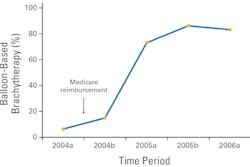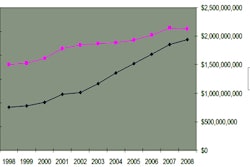The risk of developing a second cancer from radiation therapy is very low, according to a study of nearly 650,000 cancer survivors published online March 31 in the Lancet Oncology. For every 1,000 patients who receive radiation therapy, only three will develop a cancer within 10 years as a result of the treatment.
While it is well-documented that cancer survivors have an up to 14% higher risk of developing additional cancers than the average population, few estimates have been made about what percentage of the risk is related to radiation exposure from radiation therapy.
The study from the U.S. National Cancer Institute (NCI) used nine Surveillance, Epidemiology, and End Results (SEER) cancer registries to identify the number of adult cancer survivors who developed second cancers five or more years following treatment. A total of 60,271 patients, or 9%, were identified out of a total of 647,672 registered between 1978 and 2007.
The patients with cancer recurrences were followed between five and 34 years, ending at the date of diagnosis of any second cancer, death, or the study cutoff date of December 31, 2007. The five-year follow-up period was selected because there is at least a five-year lag between radiation exposure and solid cancer induction.
Amy Berrington de González, PhD, an investigator in the NCI's Radiation Epidemiology Branch, and colleagues then identified the patients who had undergone radiotherapy treatments for one of 15 types of cancer.
Overall, an estimated 3,266 five-year survivors -- 5.4% of the cancer-recurring group -- developed second solid cancers that could be related to radiation therapy. Approximately 35% were prostate cancer patients, who had an attributable risk of 10%. Breast cancer patients represented the second largest group, at 20%, with a risk of 5%. Patients who had been treated for testicular seminomas, while representing only 4.5% of the group, had the highest attributable risk of second cancer recurrence at 24%.
Relative risk was highest for organs that typically received a radiation dose greater than 5 Gy. Relative risks increased significantly for each year the patient survived, the authors reported. In fact, 15-year survivors had a five out of 1,000 chance of developing a second cancer. However, the opposite was true for older patients, perhaps due to the likelihood of dying from other causes five or more years following treatment.
For this study, the effects of intensity-modulated radiation therapy (IMRT) could not be assessed. A future study needs to be undertaken to determine if IMRT increases second-cancer risks because of the greater volume of tissue that receives low-level radiation exposure, the authors recommended.



















